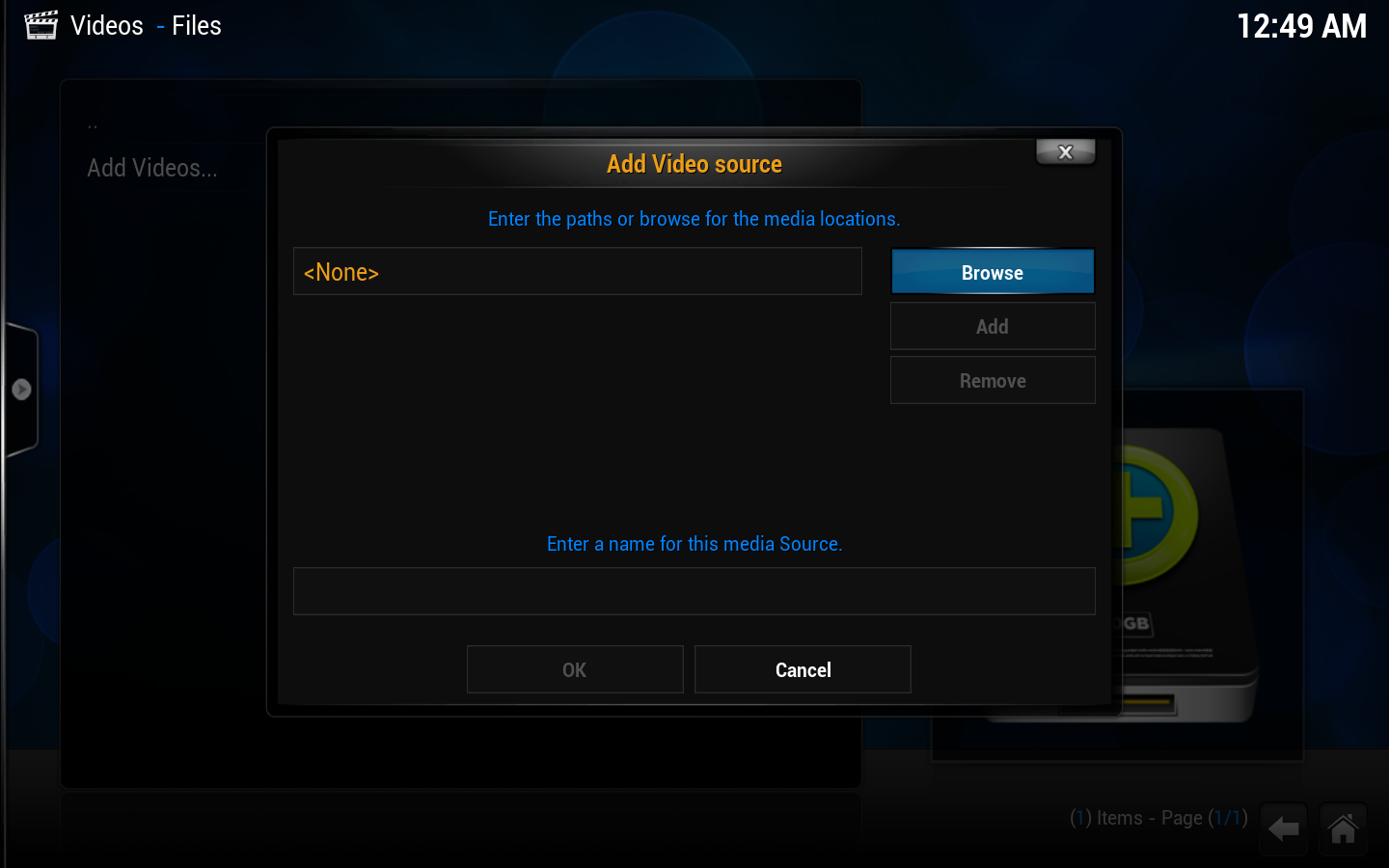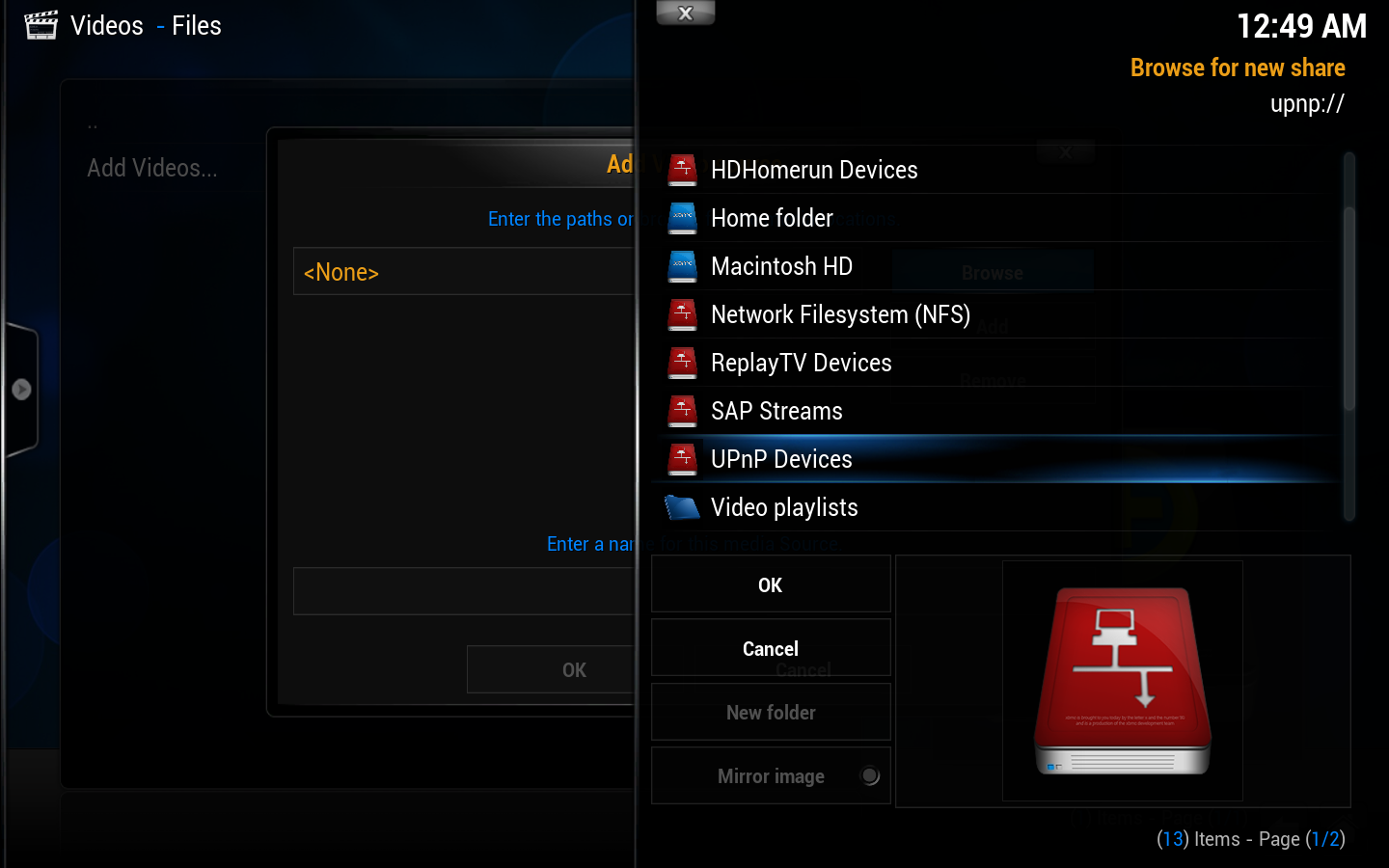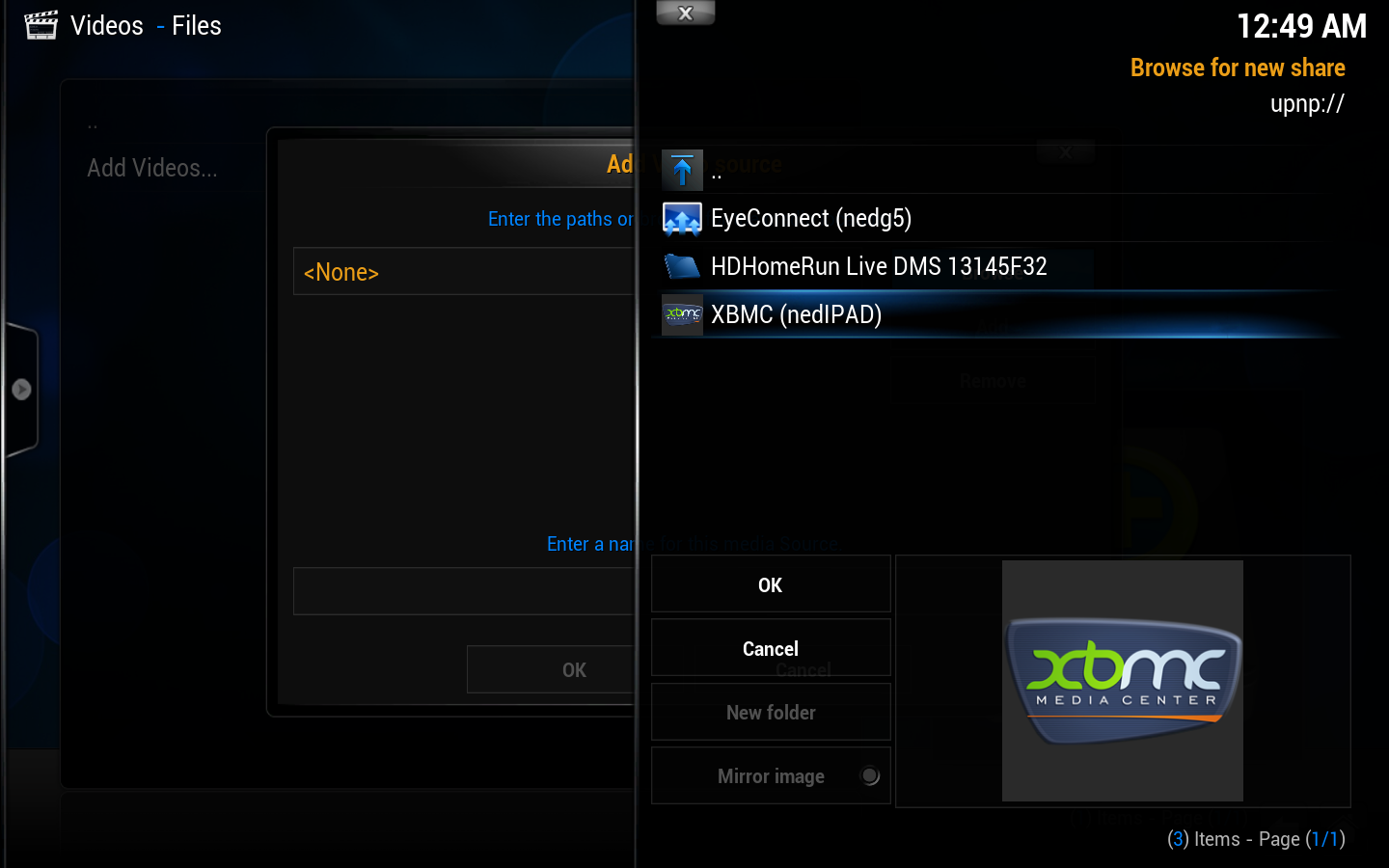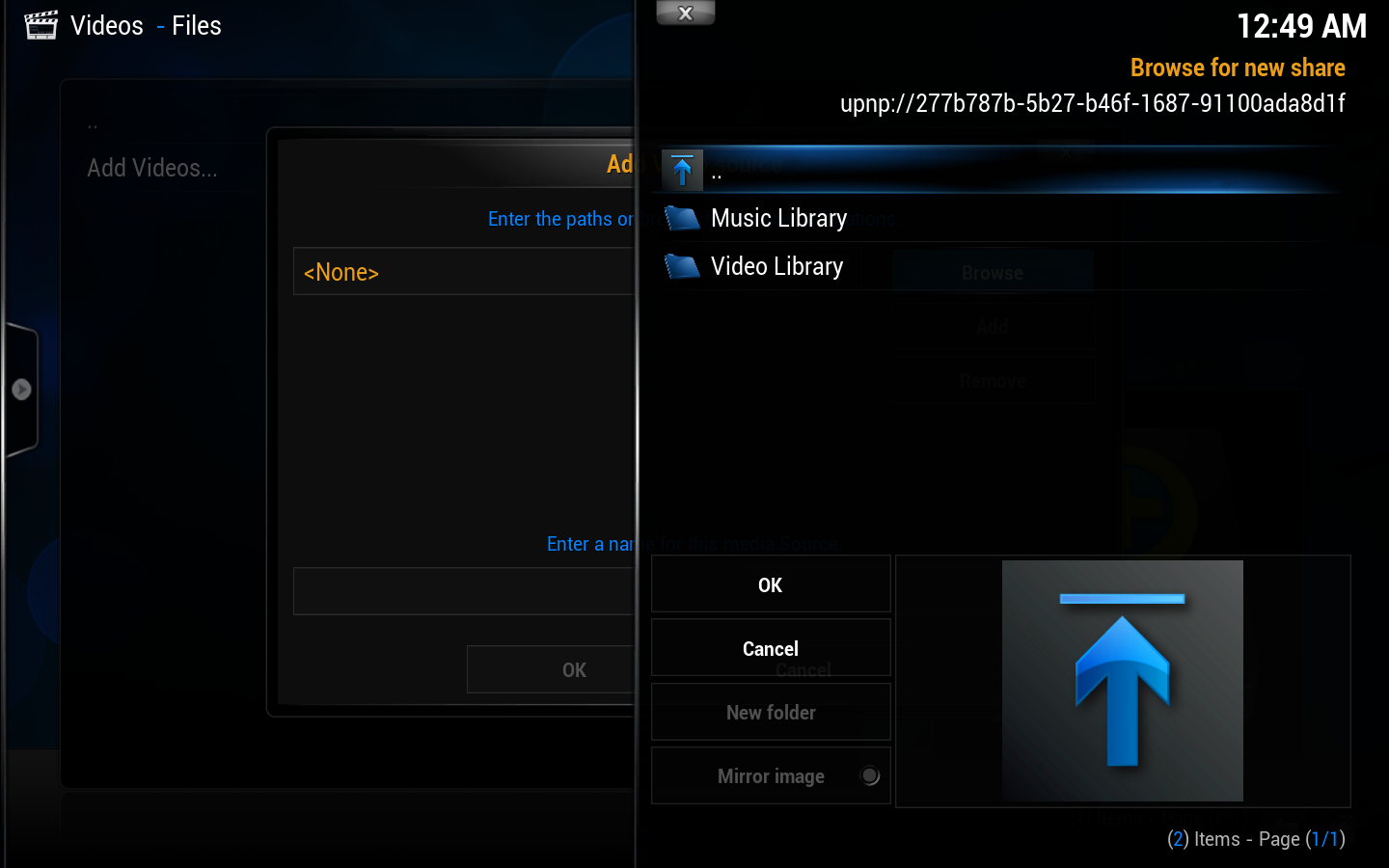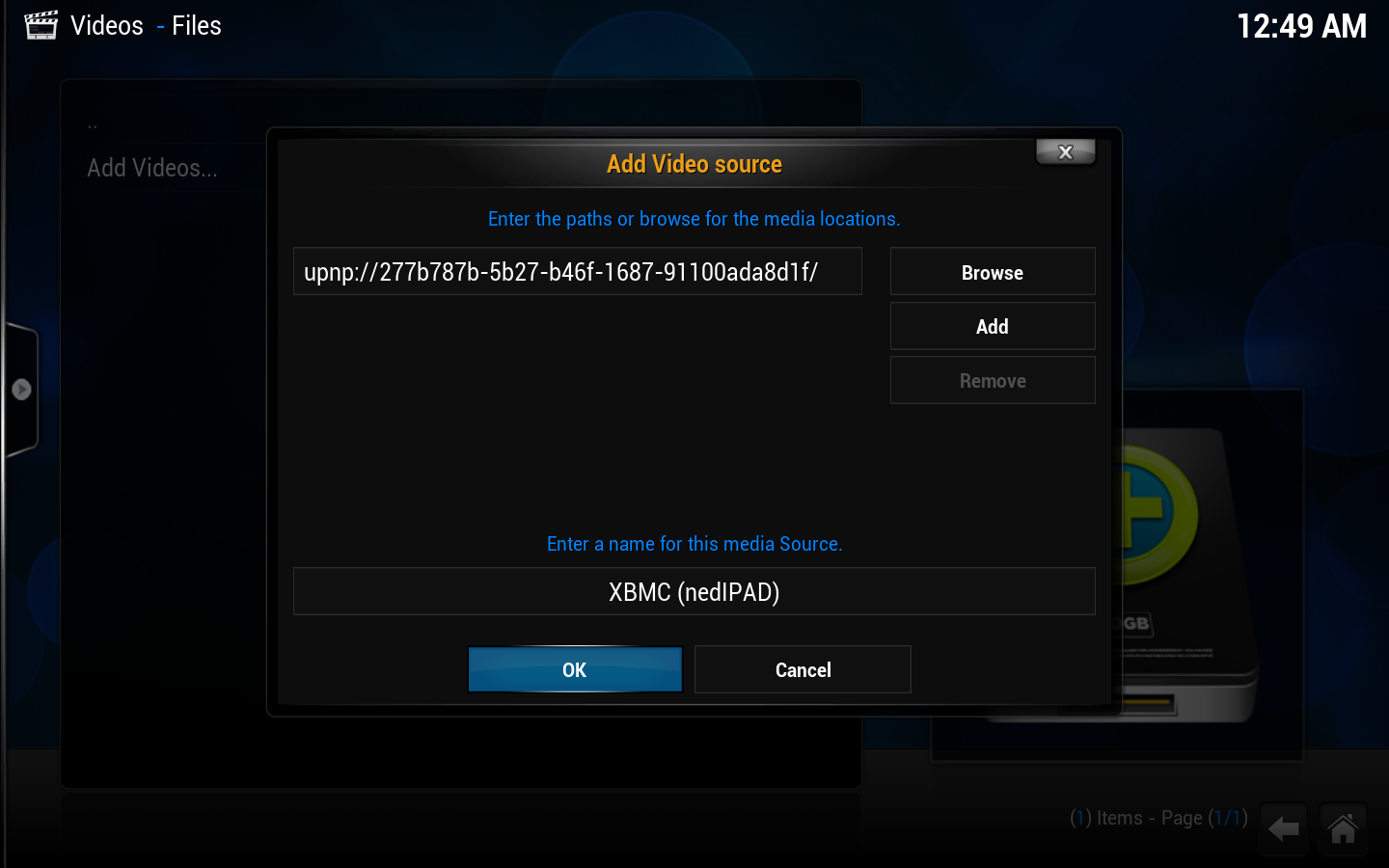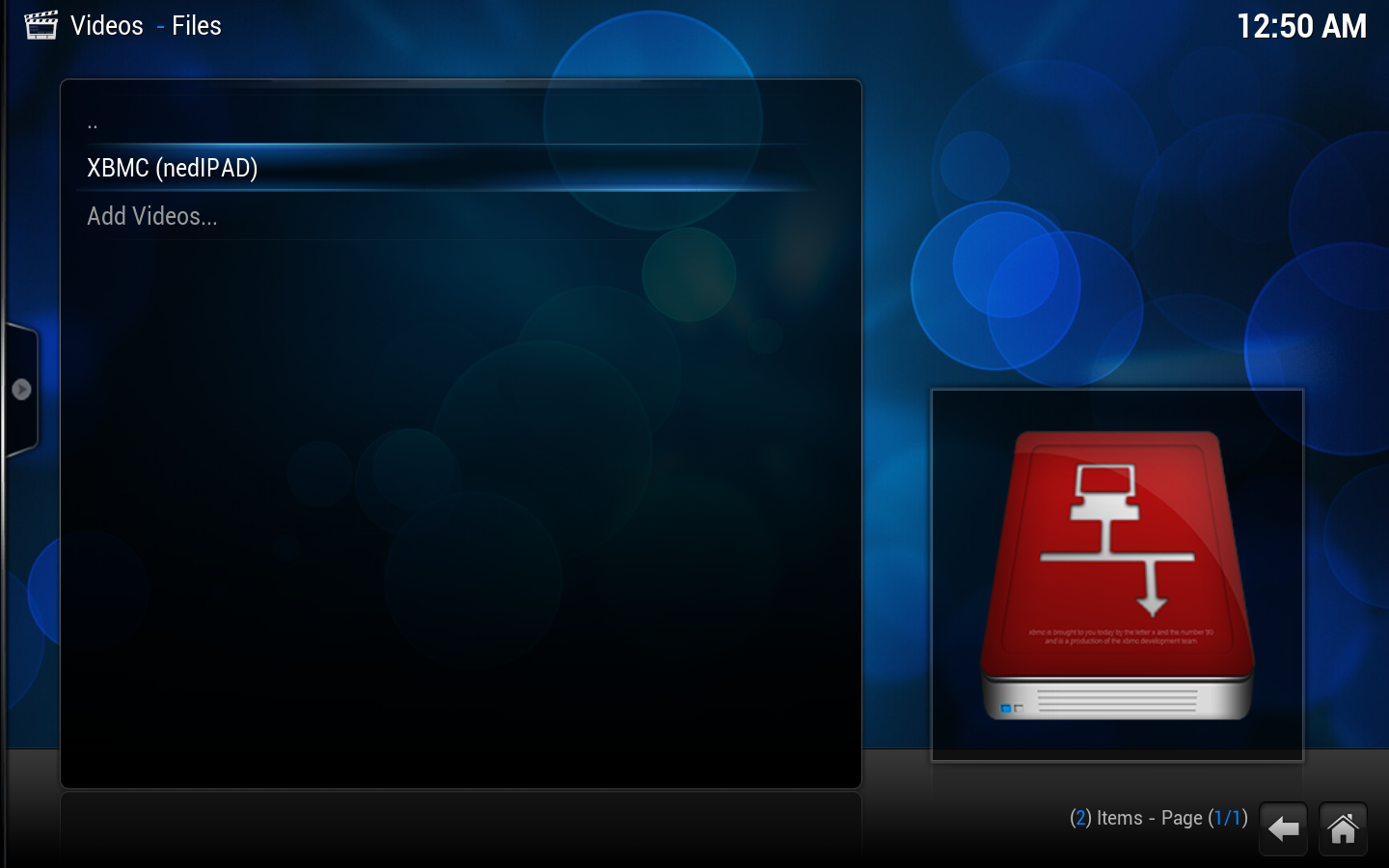Archive:UPnP/Media source: Difference between revisions
| Line 10: | Line 10: | ||
UPnP file sources can be used in videos, music, and pictures. Configuring UPnP file sources in XBMC is as easy as setting up any other type of file source, such as [[SMB]] or [[NFS]]. | UPnP file sources can be used in videos, music, and pictures. Configuring UPnP file sources in XBMC is as easy as setting up any other type of file source, such as [[SMB]] or [[NFS]]. | ||
<gallery> | <gallery widths=500px heights=281px> | ||
File:UPnP source1.png|'''Step 1:''' Go into ether videos, music, or picture file views, depending on the content you want to add, and use the "add" button to bring up this window.<br/>'''Step 2:''' Then click on the "browse button" on the right hand side. | File:UPnP source1.png|'''Step 1:''' Go into ether videos, music, or picture file views, depending on the content you want to add, and use the "add" button to bring up this window.<br/>'''Step 2:''' Then click on the "browse button" on the right hand side. | ||
File:UPnP source2.png|'''Step 3:''' This new window will pop up. Scroll down and select "UPnP Devices" | File:UPnP source2.png|'''Step 3:''' This new window will pop up. Scroll down and select "UPnP Devices" | ||
Revision as of 08:06, 8 February 2013

|
This page or section may require cleanup, updating, spellchecking, reformatting and/or updated images. Please improve this page if you can. The discussion page may contain suggestions. |
UPnP media sharing is an extremely easy method of sharing your media (pictures/video/audio) on your network as it features automatic-discovery and does not require any configuration.
UPnP (short for "Universal Plug and Play") is a set of computer network protocols from the UPnP Forum. The goals of UPnP are to allow UPnP devices on a network to detect each other and connect seamlessly, without the need for manual configuration on the users end, and then be able to share/stream data (usually video and audio files). For a more detailed explanation on the inner working of UPnP please read the "Developers notes on UPnP" section at the end of this article. There are three main types of UPnP AV (Audio/Video) device control protocols (also called profiles); there is the "UPnP AV MediaServer" which sole purpose is to share content, and there rhe "UPnP AV MediaRenderer" which render content to exposes an interface to control the playback, and then there is the "UPnP AV MediaServer ControlPoint" which can detect/find "UPnP AV MediaServer" and browse them to read media/data from them. A DMP (Digital Media Player) like XBMC typically only implements the "UPnP AV MediaServer ControlPoint" device profile.
The drawback is that an upnp Server only sends metadata and so it is not possible to integrate the upnp shares into the XBMC library.
Setting up UPnP file sources in XBMC
UPnP file sources can be used in videos, music, and pictures. Configuring UPnP file sources in XBMC is as easy as setting up any other type of file source, such as SMB or NFS.
Compatible UPnP MediaServers (UPnP-servers)
UPnP AV MediaServers (UPnP-servers) is where you store and share your media (pictures/videos/audio/music) files from. There are UPnP MediaServers available for most operating-systems and many hardware-platforms, and those UPnP AV MediaServers can be either be categorized as 'software-based' or 'hardware-based'. Software-based MediaServers can be run on PC (personal-computer), mainly on Win32, Linux, BSD, Unix or Mac operating-systems platforms. And, hardware-based MediaServers may run on any NAS (Network Attached Storage) or any specific hardware designed for delivering media, like for example a PVR (Personal Video Recorder) or DVR (Digital Video Recorder) set-top box. Currently, there are more software-based MediaServers than hardware-based, but chances are that will change in the near future as UPnP becomes a more popular standard for network connectivity.
UPnP MediaServer software
- Feel free to add any tested UPnP AV MediaServer (UPnP-server) software compatible with XBMC to this list.
- More untested UPnP-servers can be found here => http://en.wikipedia.org/wiki/UPnP_AV_MediaServers
Free UPnP MediaServers
- XBMC Media Center (Linux/Mac/Windows), XBMC builds have since the 24th of January 2007 had a built-in UPnP MediaServer.
- Windows Media Connect, Microsoft's free closed source UPnP MediaServer for Windows.
- Windows Media Player 11, Microsoft's WMP version 11 for Windows has a built-in closed source UPnP MediaServer
- TVersity, a free closed source UPnP AV Media Server for Windows, (also features nice on-the-fly transcoding funcationlity and can share internet audio/video contents too).
- Philips Media Manager (Streamium), a free closed source UPnP MediaServer for Windows and Macintosh. Note: The Macintosh version has been in beta since 2004 and downloads an update hidden in %user/.Philips/MediaManager/updates/3.1.4.0000.exe which should be renamed to 3.1.4.0000.dmg and mounted. It will also constantly request to download the update. (from Streamium OSX support forum)
- GeeXboX ushare, a free open source UPnP MediaServer for Linux and NSLU2.
- GMediaServer, a free open source UPnP MediaServer for Linux.
- MediaTomb, a free open source UPnP MediaServer for Linux.
- CyberMediaGate, a free open source UPnP MediaServer for Windows/Macintosh/Linux/UNIX, (reference implementation of UPnP MediaServer integrates into MythTV PVR for Linux)
- PyMedS, a free open source Python UPnP MediaServer for Windows/Macintosh/Linux/UNIX.
- Cidero Internet Radio Server, a free open source Java UPnP MediaServer for Windows/Macintosh/Linux/UNIX (Internet Radio Server only, SHOUTcast by default).
- Platinum UPnP SDK, a dual license open source/commercial UPnP Media Control/Renderer/Server SDK for Windows, Linux, Mac. This is what XBMC uses.
- Coherence, a free UPnP/DLNA MediaServer written in Python.
- llink, a free UPNP Media Server for Mac OS X, Windows, Linux, Unix, Embedded NAS, Media Players (NMT, popcornhour etc).
Commercial UPnP MediaServers
- Mezzmo, by Conceiva, a commercial DLNA/UPnP Media Server and Media Organizer for Windows with on-the-fly transcoding functionality.
- TwonkyMedia, by TwonkyVision, a commercial UPnP Media Server for Windows and Linux, (can interface with the third-party applications iTunes, WinAmp, and Adobe Photoshop Album, and work as plugin to give those applications UPnP-server function), it can even run as a background service on Windows.
- On2Share, a commercial UPnP MediaServer plugin for MCE (Microsoft XP Windows Media Center Edition).
- SnapStream BTV/BeyondTV, a commercial Media Control/Renderer/Server and PVR for Windows.
- Nero MediaHome (part of Nero Premium), a commercial Media Control/Renderer/Server for Windows, (also features nice on-the-fly transcoding functionality and media organizing).
- Cyberlink PowerCinema, a commercial Media Control/Renderer/Server for Windows, (also features nice media organizing functionality).
- Elgato AV Media Streaming Server, a commercial UPnP MediaServer plugin for EyeTV (Elgato PVR software for Macintosh), (also features nice media organizing functionality).
- AwoX, provides a family of commercial UPnP products and solutions.
- PlayOn (by MediaMall), a UPnP MediaServer with built-in transcoder which enable you to watch Internet video from services and websites including Netflix, Hulu, CBS, ESPN and many more. (PlayOn is still Beta but a fully featured release is coming soon).
- Allegro Media Server (AMS), a closed source UPnP MediaServer for Windows and Macintosh, (can interface with the third-party application iTunes, and work as plugin to give iTunes a UPnP-server). A time limited demo is available, registration is $39.95.
- Majestic, a UPNP AV Media server for Mac OS X. Current versions are Intel only, but previous versions work on PPC as well. 10-day trial.
- ArkMC, a UPnP/DLNA multimedia software application for iOS (iPhone, iPad, iPod Touch) and Android. Limited functionality free trial.
UPnP MediaServer hardware
- NSLU2, a hacked/modded version running ushare (a free open source UPnP MediaServer for Linux), (connect USB 2.0 drives to the NSLU2 and share).
- D-Link DSM-G600 wireless storage enclosure, (connect USB 2.0 drives to the NSLU2 and share).
- Maxtor Shared Storage Family.
- D-Link DSM-602H 20GB Central Home Drive.
- Buffalo Media Server.
- Netgear ReadyNAS Duo, (features room for 2 internal hot swapable SATA-drives, supports RAID-0/1 (Xraid) )
- Infrant ReadyNAS X6/600, (features room for four internal IDE/ATA-drives, supports RAID-0/1/5)
- Synology NAS stations.
